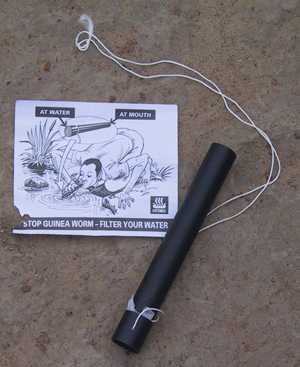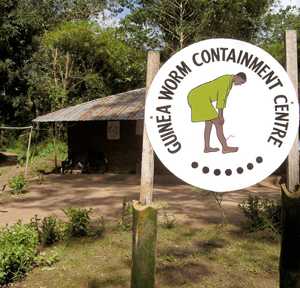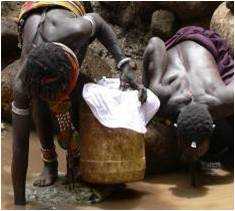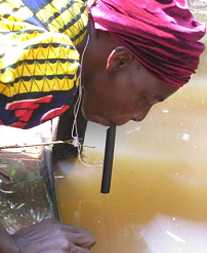Prevention & Control
GWEP Interventions

Pipe filter in Sudan. Photo credit: Sharon Roy, 2002, CDC.
The Guinea Worm Eradication Program (GWEP) includes a group of national and international partners whose purpose is to support the global eradication of Guinea worm disease (GWD). GWEP provides these guidelines for interventions that focus on preventing the spread of GWD:
- Surveillance (case detection) and case containment
- Provision of safe drinking water
- Vector control using a chemical larvicide
- Health education and community mobilization.
Many of these interventions are provided by village volunteers, people who are selected by the community to work with the GWEP. Village volunteers are the backbone of the program. In their communities, they identify and treat people with GWD and prevent them from contaminating drinking water sources (case containment). They also distribute filters and provide community health education.
Surveillance and Case Containment
GWEP village volunteers are at the front lines of Guinea worm surveillance. Every day they look for GWD in their village. Every month they report the total number of cases detected in their communities to their supervisors. The supervisors compile this information from multiple villages and send it to the national GWEP headquarters. This information is then shared with The Carter Center, the World Health Organization (WHO), and CDC. The GWEP uses this information to identify the location of cases and to understand how the disease is spreading. The GWEP also uses this information to manage the program and focus resources.

Case containment center in Nigeria. Photo credit: Emily Staub, 2004, The Carter Center.
Case containment is one of the key methods used to prevent the spread of GWD. Special case containment centers have been built in strategic locations in several countries[1]. These centers provide treatment and support to people with GWD and prevent them contaminating water sources. A case of GWD is considered to be contained when[2]:
- The person is identified within 24 hours of the worm emerging; AND
- The person has not entered any water source since the worm has emerged; AND
- The person receives proper treatment and case management by a local health provider; AND
- Within 7 days of the worm emerging, a GWEP supervisor determines that the above criteria have been met and the case is truly GWD.
Safe Water

Guinea worm filter cloth. Photo credit: WHO Collaborating Center at CDC archives.

Nigerian woman using a pipe filter to drink water directly from a pond. Photo credit: Emily Staub, 2002, The Carter Center.
Safe drinking water sources include bore-hole wells and dug wells or springs with protective walls around them and caps that prevent infected people with worms emerging from wading and contaminating the water. Flowing water, such as that found in a stream or river, is also safe from Guinea worm. The GWEP advocates for the development and repair of safe drinking water sources. It also encourages treatment of potentially contaminated drinking water. In addition, the GWEP monitors the progress of well installation and the status of safe water supplies in each village where cases of GWD have recently occurred. Often there are no safe water supplies in these villages. Therefore, fine-mesh cloth filters are given to households to strain out the infected copepods (tiny "water fleas") from contaminated drinking water. Copepods live in stagnant water and become infected when they eat Guinea worm larvae released into the water. People who travel or work away from the household might not have access to filtered water, so they are given individual pipe filters. These devices are used like straws to drink water from unsafe water sources.
Vector Control
A vector is an organism that carries or transmits disease. The vector for GWD is the copepod. To control this vector, the GWEP puts a measured amount of approved chemical larvicide, such as ABATE®*, into the water sources that are suspected to be contaminated. This chemical kills the copepods and prevents people becoming infected with GWD when they drink the water.
Health Education and Community Mobilization
Health education and community mobilization are important aspects of GWD eradication. Activities include:
- Teaching communities about the disease and how it is spread
- People are educated during household visits by GWEP volunteers and staff and through organized events, such as Worm Weeks.
- Helping villagers take action against the disease
- Preventing people with worms emerging from entering and contaminating drinking water supplies
- Using water filters to protect against GWD
- Helping villagers understand the need for safe chemical larvicide in their water supplies.
*Use of trade names is for identification only and does not imply endorsement by the Public Health Service or by the U.S. Department of Health and Human Services.
Reference
- Hochberg N, Ruiz-Tiben E, Downs P, Fagan J, Maguire JH. The Role of Case Containment Centers in the Eradication of Dracunculiasis in Togo and Ghana. Am J Trop Med Hyg, 2008. 79(5): 722–8.
- WHO Collaborating Center for Research Training and Eradication of Dracunculiasis, Guinea Worm Wrap Up #194. 2010, Centers for Disease Control and Prevention (CGH): Atlanta.
- Page last reviewed: November 21, 2012
- Page last updated: November 21, 2012
- Content source:


 ShareCompartir
ShareCompartir